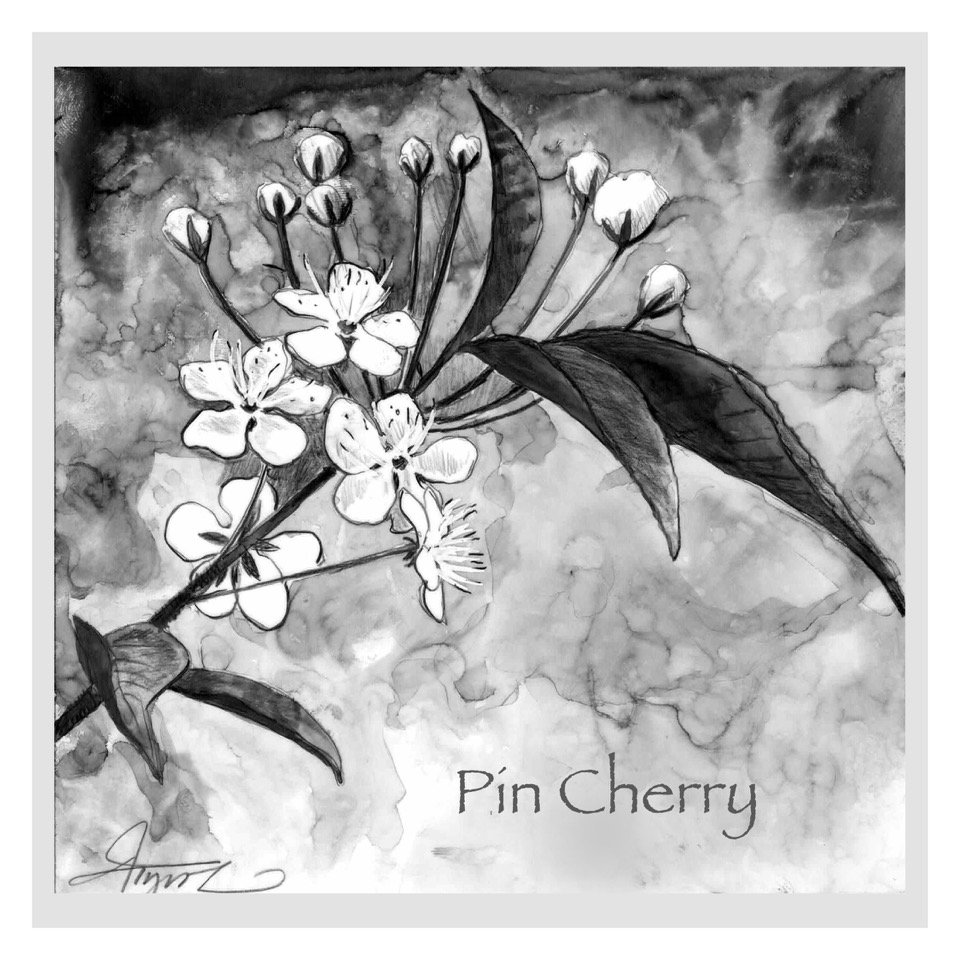Native cherry trees offer spring beauty, ecological gold
May 21, 2024 | By Laurie D. Morrissey | The Outside StoryIllustration by Adelaide Murphy Tyrol
Each spring, cities from New York to Texas celebrate the spectacular blooming of ornamental cherry trees. In many cultures, the lovely, delicate pink and white cherry blossoms symbolize rebirth and renewal, as well as the fleeting nature of life.
Beyond these showy cultivated trees, our region boasts three native cherry species, which are important in regeneration of disturbed forests and as a source of food and shelter for a variety of wildlife.
New England’s wild cherry trees share a genus (Prunus) with those cultivated beauties, but their flowers are more modest. Our region’s native cherry species are black cherry, choke cherry, and pin cherry (also known as fire cherry). Members of the rose family, cherry trees are relatives of apple, pear, and plum, as well as woodland trees such as serviceberry and mountain ash. All three natives share a cherry fragrance and bitter almond taste derived from trace amounts of hydrogen cyanide. (If you’re not sure whether you’ve found a cherry tree, break off a twig and give it a sniff or a taste.)
Black cherry (Prunus serotina) is the largest of the native trio. In the Northeast, specimens grow individually and in small stands, often reaching heights of 50 to 60 feet. Because they are intolerant of shade, cherries often grow along stone walls and hedgerows. “It’s not common in our mature forests except in enriched sites where leaves and soil nutrients accumulate from slopes above,” said Dave Anderson, senior director of education for the Society for the Protection of New Hampshire Forests, of black cherry. He noted that black cherry may also occur in second-growth hardwood forests.
Some of New Hampshire’s oldest black cherry trees are taller than 80 feet, but the most impressive specimens grow in the Allegheny Plateau in Pennsylvania, where the species is prized for its timber value. Furniture makers and crafters appreciate the wood for its rich, reddish-brown color, hardness, and close grain. For use as lumber, cherry trees need to be straight-grained, disease-free, and without branches for at least 10 feet.
“The poor quality of New England soils lowers the quality of the black cherry timber compared with further south,” Anderson said. “Here it’s often marginal for timber and ends up in the firewood pile, except in the best sites.”
In the Northeast, the black cherry’s drooping spikes of flowers bloom in mid-May or early June, about a week after the leaves emerge. Even without its white flowers or tapered leaves, it is easy to identify this tree by its bark. The bark of young trees is reddish brown and has horizontal white marks called lenticels. The bark of mature trunks is dark gray and broken into plates that are curved slightly upward at the edges. It is often described as looking like burnt cornflakes.
Pin and choke cherry are brushy trees that typically are not as long-lived as black cherry and rarely grow more than 30 feet tall. Like black cherry, they thrive in open areas with lots of sun, springing up in old fields and in forest areas that have been disturbed by logging, fire, or storms. These two species grow rapidly in such areas, Anderson said, and help to stabilize soil, allowing other tree species to eventually become established.
All three of our region’s native cherry trees have attractive flowers and brilliant fall foliage, but their greatest virtue may be their value to wildlife. Renowned entomologist Doug Tallamy calls Prunus “ecological gold,” and notes that cherry is second only to oak in supporting the terrestrial food web.
Cherry trees provide food for mammals and birds, and they host more than 450 species of butterflies and moths, according to Tallamy. “Unfortunately, many people consider [cherry trees] weedy because they make so many fruits that germinate where people don’t want them,” he said. “People often turn their landscapers loose on them, cutting them all out.”
Among the invertebrate species partial to black cherry trees are eastern tent caterpillars and fall webworms, which weave unattractive webs in the branches. In a high tent caterpillar year (a bonus for cuckoos, which are voracious caterpillar eaters), caterpillars can defoliate their host trees. Most trees survive the damage, however, and put out new leaves in the same season.
Given their role in regenerating forests and feeding the wildlife that lives there, cherry trees are definitely worth their weight in ecological gold.
Laurie D. Morrissey is a writer who lives in Hopkinton, New Hampshire. The Outside Story is assigned and edited by Northern Woodlands magazine and sponsored by the Wellborn Ecology Fund of the New Hampshire Charitable Foundation.

